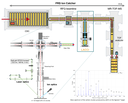News
News from the workgroup
A new experimental campaign to measure a predicted nuclear decay mode, double alpha decay, was conducted at the FRS Ion Catcher in 2022. In July 2024, the data analysis group met in Orsay (France) to summarise the interim results and facilitate further progress.
In May this year, exploratory experiments for the Multi-Nucleon Transfer (MNT) reaction were successfully performed at the FRS Ion Catcher, highlighting the first-time use of the slowed down relativistic beams. This achievement is a key milestone towards a new research direction for performing coulomb barrier reactions with secondary beams inside the cryogenic stopping cell of the Super-FRS Ion Catcher, thus is a major step towards the full science program during ES and FS.
Our tandem MR-TOF-MS reached above 100.000 separation power for isolating precursors! By extending our homemade timing sequence control device and control software, we can now also measure MS^4. Precursor-ions are re-captured in up to 3 stages, with CID applied in each stage, before the spectrum is measured with 250.000 resolving power.
We successfully measured insulin (m=5810u) at the Tandem-MR-TOF-MS in charge states 7+ (830u) to 4+ (1453u) with NA and K aducts. This proves that such proteins survive transport to the detector. Together with past measurements on crude oil residue (EE45, Dillbit) and dissolved analytes (Glutamine/Lysin/Caffeine) this shows the versatibility of application for the device.
The laser ablation carbon cluster ion source (LACCI) for the MR-TOF-MS of the FRS-IC has been built and commissioned. It is capable of providing closely-spaced calibrant ions in the mass range up to ~300 u for highly accurate mass measurements of exotic nuclei (σm/m ~10-8) and systematic studies of the mass uncertainties with the MR-TOF-MS of the FRS Ion Catcher at GSI Darmstadt, Germany. This novel ion source with many newly developed advanced techniques,including 2D motion of the target, laser-spot/target monitoring system, and dedicated re-capture unit, will enhance the performance of the MR-TOF-MS in FRS Ion Catcher.
INCREASE (in-cell reaction system) setup with the short DC cage was used for the first time to extract fission fragments by the spontaneous fission of Cf-252. The source is installed inside the Cryogenic Stopping Cell (CSC), which sends the ions further to MR-TOF-MS at the FRS Ion Catcher facility at GSI Darmstadt. The modified form of the DC cade first electrode, INCREASE, consists of a target wheel, a beam dump, and a space charge suppression system; and the shorter length of the DC cage enables the faster extraction of ions stopped inside the CSC. Along with the magnificent resolving power (~1,000,000), mass accuracies down to a few 1E-8, and high background suppression by the MR-TOF-MS, the whole system is capable of measuring highly energetic fission fragments with very short half-lives. The image below shows the spectrum of Cf-252 fission fragments extracted using an INCREASE setup with a short DC cage for the first time.
A new procedure allows high-precision broad-band analytical mass analysis with our Tandem MR-TOF-MS at Gießen. We extended the control and analysis software with half-automatic analysis and prediction features. Over 500 fragments were measured in tandem-MS with sub-ppm accuracy and 30k precursor selection power within a 300-minute long measurement.
A new homemade µ-ESI Source was designed, commissioned, and tested at the Tandem MR-TOF-MS in Gießen. Casing 3D-printed of PLA. 10-500 µl/min producing around 200 nA ion current. Excellent performance, and no clogging, even with crude oil samples!
The Tandem MR-TOF-MS at Gießen is now fully operatable. It features up to 300k resolving power, sub-ppm accuracy, and 100k precursor selection power in tandem mass spectrometry, different ion sources, and fully customized software. The following measurements will be acquired and analyzed within our collaboration with the MPI for carbon research in Mühlheim a. d. Ruhr.








